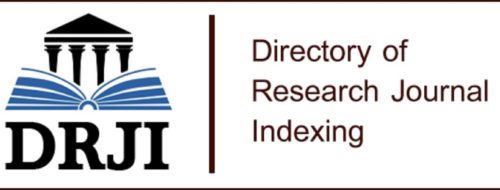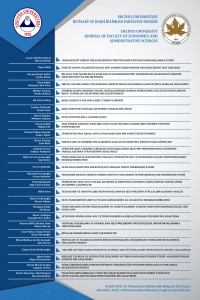Öz
Bu çalışmanın amacı, Pozitif Sapma Davranışları ölçeğinin devamlılığını Hirschi’nin Sosyal
Bağ Teorisi’nden hareketle oluşturulan bir araştırma modeli ile test etmektir. Bu doğrultuda araştırma
kapsamı örgütsel bağlılığın, pozitif sapma üzerindeki etkileri ile sınırlandırılmıştır. Araştırmada nicel
araştırma yöntemlerinden anket tekniği kullanılmıştır. Araştırma Bursa, Türkiye’de yürütülmüştür.
Araştırma örneklemi 314 üniversite mezunu özel sektör çalışanından oluşmaktadır. Araştırma
sonucunda geliştirilen ölçeğin orijinal faktör yapısı bu araştırmada da elde edilmiştir. Bulgular her ne
kadar ölçeğin devamlılığını destekler nitelikte ise de pozitif sapma ölçeğinin örgüt dışı aidiyetler
boyutunun faktör analizi sürecinde çok sayıda ifade kaybetmesi, ilgili boyut üzerine daha fazla
araştırma yapılarak geliştirilmesi gerekliliğini ön plana çıkarmaktadır. Ayrıca elde edilen bulgular
Sosyal Bağ Teorisi’ni destekler niteliktedir. Bu kapsamda, örgütsel bağlılığın alt boyutu olan
duygusal bağlılığın tüm pozitif sapma alt boyutları üzerinde negatif etkileri olduğu sonucu ile;
normatif bağlılığın bireysel verimlilik ve örgüt dışı aidiyetler temelinde pozitif sapma üzerinde yine
negatif etkili olduğu; devam bağlılığının ise örgütün sürdürülebilir başarısı temelinde pozitif sapma
üzerinde pozitif etkili olduğu sonuçlarına ulaşılmıştır. Bu sonuçlar çalışanın örgütü ile güçlü
bağlarının örneğin bireysel verimliliği arttırmak gerekçesiyle bile olsa örgüt normlarından
uzaklaşmasını engellerken; diğer taraftan zayıf bağların çalışanların sürdürülebilir başarı elde
edilmesi için örgüt normlarından uzaklaşmasına vesile olabilir şeklinde yorumlanabilir.
Anahtar Kelimeler
Kaynakça
- Abrams, D., Marques, J., Bown, N., & Dougill, M. (2002). Anti-Norm and ProNorm Deviance in the Bank and on the Campus: Two Experiments on Subjective Group Dynamics. Group Processes & Intergroup Relations, 5(2), 163–182. https://doi.org/10.1177/1368430202005002922
- Agnew, R. (1992). Foundation for a General Strain Theory of Crime and Delinquency. Criminology, 30(1), 47–88. https://doi.org/10.1111/j.1745- 9125.1992.tb01093.x
- Braithwaite, J. (1989). Crime, Shame and Reintegration. Cambridge University Press. https://doi.org/10.1017/CBO9780511804618
- Brief, A. P., Buttram, R. T., & Dukerich, J. M. (2001). Collective corruption in the corporate world: Toward a process model. In Groups at work: Theory and research. (pp. 471–499). Mahwah, NJ, US: Lawrence Erlbaum Associates Publishers.
- Campbell, D. T., & Fiske, D. W. (1959). Convergent and discriminant validation by the multitrait-multimethod matrix. Psychological Bulletin. US: American Psychological Association. https://doi.org/10.1037/h0046016
- Clugston, M., Howell, J. P., & Dorfman, P. W. (2000). Does Cultural Socialization Predict Multiple Bases and Foci of Commitment? Journal of Management, 26(1), 5–30. https://doi.org/10.1177/014920630002600106
- Cohen, A. K. (1965). The Sociology of the Deviant Act: Anomie Theory and Beyond. American Sociological Review, 30(1), 5–14. https://doi.org/10.2307/2091770
- Darley, J. M. (1995). Constructive and Destructive Obedience: A Taxonomy of Principal-Agent Relationships. Journal of Social Issues, 51(3), 125–154. https://doi.org/10.1111/j.1540-4560.1995.tb01338.x
- Galperin, B. L. (2012). Exploring the Nomological Network of Workplace Deviance: Developing and Validating a Measure of Constructive Deviance. Journal of Applied Social Psychology, 42(12), 2988–3025. https://doi.org/10.1111/j.1559-1816.2012.00971.x
- Gaulejac, D. V. (2013). İşletme Hastalığına Tutulmuş Toplum, (Çev. Ö. Erbek), Ayrıntı, İstanbul.
- Graham, J. W. (1986). Principled organizational dissent: A theoretical essay. Research in Organizational Behavior, 8, 1–52.
- Greenberg, J. (1990). Employee theft as a reaction to underpayment inequity: The hidden cost of pay cuts. Journal of Applied Psychology, 75(5), 561–568. https://doi.org/10.1037/0021-9010.75.5.561
- Grover, S. L. (1993). Lying, Deceit, and Subterfuge: A Model of Dishonesty in the Workplace. Organization Science, 4(3), 478–495. Retrieved from http://www.jstor.org/stable/2634955
- Grover, S. L. (1997). Lying in organizations : theory, research, and future directions. In J. G. Robert A. Giacalone (Ed.), Antisocial behavior in organizations (pp. 68–84). Thousand Oaks, CA: SAGE Publications Inc.
- Heckert, D., Morooka, H., & Heckert, A. (2019). Perched on a Pedestal in a Positive Deviance Profession. Deviant Behavior, 1–16. https://doi.org/10.1080/01639625.2019.1653430
- Heckert, A. ve Ünlü, O. (2013) "Pozitif Sapma Davranışı: Yeni Bir Tanım Arayışı", 1. Örgütsel Davranış Kongresi Bildiriler Kitabı içinde (149- 152) 15/16 Kasım, Sakarya.
- Hinkin, T. R. (1995). A Review of Scale Development Practices in the Study of Organizations. Journal of Management, 21(5), 967–988. https://doi.org/10.1177/014920639502100509
- Hirschi, T. (1969). Causes of delinquency. Berkeley: University of California Press.
- Hollinger, R. C., & Clark, J. P. (1982). Formal and Informal Social Controls of Employee Deviance*. The Sociological Quarterly, 23(3), 333–343. https://doi.org/10.1111/j.1533-8525.1982.tb01016.x
- Liao, H., Joshi, A., & Chuang, A. (2004). Sticking Out Like a Sore Thumb: Employee Dissimilarity and Deviance at Work*. Personnel Psychology, 57(4), 969–1000. https://doi.org/10.1111/j.1744-6570.2004.00012.x Mainemelis, C. (2010). Stealing Fire : Creative Deviance in the Evolution of New Ideas. Academy of Management Review, 35(4), 558–578.
- McClellan, S., & Beggan, J. K. (2017). The Stigma of Being Young on the Experience of Rate-Busting as Positive Deviance. Deviant Behavior, 38(9), 1059–1073. https://doi.org/10.1080/01639625.2016.1237836
- Mertens, W., Recker, J., Kohlborn, T., & Kummer, T.-F. (2016). A Framework for the Study of Positive Deviance in Organizations. Deviant Behavior, 37(11), 1288–1307. https://doi.org/10.1080/01639625.2016.1174519
- Meyer, J. P., & Allen, N. J. (1991). A three-component conceptualization of organizational commitment. Human Resource Management Review, 1(1), 61–89. https://doi.org/https://doi.org/10.1016/1053-4822(91)90011-Z
- Meyerson, D. E., & Scully, M. A. (1995). Crossroads Tempered Radicalism and the Politics of Ambivalence and Change. Organization Science, 6(5), 585–600. https://doi.org/10.1287/orsc.6.5.585
- Morrison, E. W. (2006). Doing the Job Well: An Investigation of Pro-Social Rule Breaking. Journal of Management, 32(1), 5–28. https://doi.org/10.1177/0149206305277790
- Mowday, R. T., Steers, R. M., & Porter, L. W. (1979). The measurement of organizational commitment. Journal of Vocational Behavior, 14(2), 224– 247.
- Near, J. P., & Miceli, M. P. (1995). Effective-Whistle Blowing. Academy of Management Review, 20(3), 679–708. https://doi.org/10.5465/amr.1995.9508080334
- Nye, F. I. (1958). Family relationships and delinquent behavior. Family relationships and delinquent behavior. Oxford, England: John Wiley.
- O’Leary-Kelly, A. M., Griffin, R. W., & Glew, D. J. (1996). OrganızationMotivated Aggression: A Research Framework. Academy of Management Review, 21(1), 225–253. https://doi.org/10.5465/amr.1996.9602161571
- O’Reilly, C. A., & Chatman, J. (1986). Organizational commitment and psychological attachment: The effects of compliance, identification, and internalization on prosocial behavior. Journal of Applied Psychology, 71(3), 492–499. https://doi.org/10.1037/0021-9010.71.3.492
- Puffer, S. M. (1987). Prosocial behavior, noncompliant behavior, and work performance among commission salespeople. Journal of Applied Psychology, 72(4), 615–621. https://doi.org/10.1037/0021-9010.72.4.615 Raelin, J. A. (1984). An Examination of Deviant/Adaptive Behaviors in the
- Organizational Careers of Professionals. Academy of Management Review, 9(3), 413–427. https://doi.org/10.5465/amr.1984.4279662
- Randall, D. M. (1987). Commitment and the Organization: The Organization Man Revisited. Academy of Management Review, 12(3), 460–471. https://doi.org/10.5465/amr.1987.4306561
- Reckless, W. C. (1970). Containment theory. The Sociology of Crime and Delinquency, 287–300.
- Reiss, A. J. (1951). Delinquency as the Failure of Personal and Social Controls. American Sociological Review, 16(2), 196–207. https://doi.org/10.2307/2087693
- Robinson, S. L., & Bennett, R. J. (1995). A Typology of Deviant Workplace Behaviors: A Multidimensional Scaling Study. Academy of Management Journal, 38(2), 555–572. https://doi.org/10.5465/256693 Shoenberger, N., Heckert, A., & Heckert, D. (2012). Techniques of Neutralization
- Theory and Positive Deviance. Deviant Behavior, 33(10), 774–791. https://doi.org/10.1080/01639625.2012.707497
- Shoenberger, N., Heckert, A., & Heckert, D. (2015). Labeling, Social Learning, and Positive Deviance: A Look at High Achieving Students. Deviant Behavior, 36(6), 474–491. https://doi.org/10.1080/01639625.2014.944066
- Sims, R. L. (2002). Ethical Rule Breaking by Employees: A Test of Social Bonding Theory. Journal of Business Ethics, 40(2), 101–109. https://doi.org/10.1023/A:1020330801847
- Spreitzer, G. M., & Sonenshein, S. (2004). Toward the construct definition of positive deviance. American Behavioral Scientist, 47(6), 828–847. https://doi.org/10.1177/0002764203260212
- Staw, B. M., & Boettger, R. D. (1990). Task Revision: A Neglected Form of Work Performance. Academy of Management Journal, 33(3), 534–559. https://doi.org/10.5465/256580
- Sykes, G. M., & Matza, D. (1957). Techniques of Neutralization: A Theory of Delinquency. American Sociological Review, 22(6), 664–670. https://doi.org/10.2307/2089195
- Tepper, B. J., Henle, C. A., Lambert, L. S., Giacalone, R. A., & Duffy, M. K. (2008). Abusive supervision and subordinates’ organization deviance. Journal of Applied Psychology. Tepper, Bennett J.: J. Mack Robinson College of Business, Georgia State University, Atlanta, GA, US, 30302- 4014, btepper@gsu.edu: American Psychological Association. https://doi.org/10.1037/0021-9010.93.4.721
- Ünlü O., (2015) Pozitif Sapma Davranışlarının Kavramsallaştırılması ve Bireyin Örgüte Yönelik Bağının Pozitif Sapma Davranışları Üzerindeki Etkisi: Öz Yeterliliğin Rolü, Erciyes Üniversitesi, Sosyal Bilimler Enstitüsü, Kayseri, (Yayımlanmamış Doktora Tezi).
- Van Dyne, L., Graham, J. W., & Dienesch, R. M. (1994). Organizational Citizenship Behavior: Construct Redefinition, Measurement, and Validation. Academy of Management Journal, 37(4), 765–802. https://doi.org/10.5465/256600
- Van Dyne, L., & LePine, J. A. (1998). Helping and Voice Extra-Role Behaviors: Evidence of Construct and Predictive Validity. Academy of Management Journal, 41(1), 108–119. https://doi.org/10.5465/256902
- Vardi, Y., & Wiener, Y. (1996). Misbehavior in Organizations: A Motivational Framework. Organization Science, 7(2), 151–165. https://doi.org/10.1287/orsc.7.2.151
- Warren, D. E. (2003). Constructive and destructive deviance in organizations. Pozitif Sapma Ölçeğinin Sosyal Bağ Teorisi Çerçevesinde Devamlılığının Test Edilmesi 39 Academy of Management Review, 28(4), 622–632. https://doi.org/10.5465/AMR.2003.10899440
- Wolfzorn, M., Heckert, A., & Heckert, D. M. (2006). Positive deviance and social bond theory. Free Inquiry in Creative Sociology, 34(2), 107.
Öz
The aim of this study, is to test the continuity of newly developed scale of Positive
Deviance. In this regard, scope of the research determined in the frame of the relations among
organizational commitment, tenure and positive deviance. Hirschi’s Social Bond Theory constitutes
theoretical background of the research model. One of quantitative methods, survey technique has
been used. The research conducted at Bursa, TURKEY. Sample consist of 314 private sector
employees. According to the findings, factor structure which is obtained by exploratory factor
analysis (EFA) is consistent with original scale. Although the findings are supportive for the
continuity of the positive deviance scale; it nevertheless also highlights that one of the sub dimensions
of the scale; social ties had lost so many items during EFA. So according to the findings number of
items of social ties dimension need to be revised. Furthermore, findings mainly support the Theory.
As one of sub dimension of organizational commitment, affective commitment has negative effects
on all positive deviance sub dimensions. Besides normative commitment to the organization has also
negative effects on PD’s social ties and work-related pride. On the contrary, continuity commitment
has positive effect on PD’s sub-dimension of higher loyalties to the organization and/or society.
Anahtar Kelimeler
Positive Deviance , Scale Development Organizational Commitment.
Kaynakça
- Abrams, D., Marques, J., Bown, N., & Dougill, M. (2002). Anti-Norm and ProNorm Deviance in the Bank and on the Campus: Two Experiments on Subjective Group Dynamics. Group Processes & Intergroup Relations, 5(2), 163–182. https://doi.org/10.1177/1368430202005002922
- Agnew, R. (1992). Foundation for a General Strain Theory of Crime and Delinquency. Criminology, 30(1), 47–88. https://doi.org/10.1111/j.1745- 9125.1992.tb01093.x
- Braithwaite, J. (1989). Crime, Shame and Reintegration. Cambridge University Press. https://doi.org/10.1017/CBO9780511804618
- Brief, A. P., Buttram, R. T., & Dukerich, J. M. (2001). Collective corruption in the corporate world: Toward a process model. In Groups at work: Theory and research. (pp. 471–499). Mahwah, NJ, US: Lawrence Erlbaum Associates Publishers.
- Campbell, D. T., & Fiske, D. W. (1959). Convergent and discriminant validation by the multitrait-multimethod matrix. Psychological Bulletin. US: American Psychological Association. https://doi.org/10.1037/h0046016
- Clugston, M., Howell, J. P., & Dorfman, P. W. (2000). Does Cultural Socialization Predict Multiple Bases and Foci of Commitment? Journal of Management, 26(1), 5–30. https://doi.org/10.1177/014920630002600106
- Cohen, A. K. (1965). The Sociology of the Deviant Act: Anomie Theory and Beyond. American Sociological Review, 30(1), 5–14. https://doi.org/10.2307/2091770
- Darley, J. M. (1995). Constructive and Destructive Obedience: A Taxonomy of Principal-Agent Relationships. Journal of Social Issues, 51(3), 125–154. https://doi.org/10.1111/j.1540-4560.1995.tb01338.x
- Galperin, B. L. (2012). Exploring the Nomological Network of Workplace Deviance: Developing and Validating a Measure of Constructive Deviance. Journal of Applied Social Psychology, 42(12), 2988–3025. https://doi.org/10.1111/j.1559-1816.2012.00971.x
- Gaulejac, D. V. (2013). İşletme Hastalığına Tutulmuş Toplum, (Çev. Ö. Erbek), Ayrıntı, İstanbul.
- Graham, J. W. (1986). Principled organizational dissent: A theoretical essay. Research in Organizational Behavior, 8, 1–52.
- Greenberg, J. (1990). Employee theft as a reaction to underpayment inequity: The hidden cost of pay cuts. Journal of Applied Psychology, 75(5), 561–568. https://doi.org/10.1037/0021-9010.75.5.561
- Grover, S. L. (1993). Lying, Deceit, and Subterfuge: A Model of Dishonesty in the Workplace. Organization Science, 4(3), 478–495. Retrieved from http://www.jstor.org/stable/2634955
- Grover, S. L. (1997). Lying in organizations : theory, research, and future directions. In J. G. Robert A. Giacalone (Ed.), Antisocial behavior in organizations (pp. 68–84). Thousand Oaks, CA: SAGE Publications Inc.
- Heckert, D., Morooka, H., & Heckert, A. (2019). Perched on a Pedestal in a Positive Deviance Profession. Deviant Behavior, 1–16. https://doi.org/10.1080/01639625.2019.1653430
- Heckert, A. ve Ünlü, O. (2013) "Pozitif Sapma Davranışı: Yeni Bir Tanım Arayışı", 1. Örgütsel Davranış Kongresi Bildiriler Kitabı içinde (149- 152) 15/16 Kasım, Sakarya.
- Hinkin, T. R. (1995). A Review of Scale Development Practices in the Study of Organizations. Journal of Management, 21(5), 967–988. https://doi.org/10.1177/014920639502100509
- Hirschi, T. (1969). Causes of delinquency. Berkeley: University of California Press.
- Hollinger, R. C., & Clark, J. P. (1982). Formal and Informal Social Controls of Employee Deviance*. The Sociological Quarterly, 23(3), 333–343. https://doi.org/10.1111/j.1533-8525.1982.tb01016.x
- Liao, H., Joshi, A., & Chuang, A. (2004). Sticking Out Like a Sore Thumb: Employee Dissimilarity and Deviance at Work*. Personnel Psychology, 57(4), 969–1000. https://doi.org/10.1111/j.1744-6570.2004.00012.x Mainemelis, C. (2010). Stealing Fire : Creative Deviance in the Evolution of New Ideas. Academy of Management Review, 35(4), 558–578.
- McClellan, S., & Beggan, J. K. (2017). The Stigma of Being Young on the Experience of Rate-Busting as Positive Deviance. Deviant Behavior, 38(9), 1059–1073. https://doi.org/10.1080/01639625.2016.1237836
- Mertens, W., Recker, J., Kohlborn, T., & Kummer, T.-F. (2016). A Framework for the Study of Positive Deviance in Organizations. Deviant Behavior, 37(11), 1288–1307. https://doi.org/10.1080/01639625.2016.1174519
- Meyer, J. P., & Allen, N. J. (1991). A three-component conceptualization of organizational commitment. Human Resource Management Review, 1(1), 61–89. https://doi.org/https://doi.org/10.1016/1053-4822(91)90011-Z
- Meyerson, D. E., & Scully, M. A. (1995). Crossroads Tempered Radicalism and the Politics of Ambivalence and Change. Organization Science, 6(5), 585–600. https://doi.org/10.1287/orsc.6.5.585
- Morrison, E. W. (2006). Doing the Job Well: An Investigation of Pro-Social Rule Breaking. Journal of Management, 32(1), 5–28. https://doi.org/10.1177/0149206305277790
- Mowday, R. T., Steers, R. M., & Porter, L. W. (1979). The measurement of organizational commitment. Journal of Vocational Behavior, 14(2), 224– 247.
- Near, J. P., & Miceli, M. P. (1995). Effective-Whistle Blowing. Academy of Management Review, 20(3), 679–708. https://doi.org/10.5465/amr.1995.9508080334
- Nye, F. I. (1958). Family relationships and delinquent behavior. Family relationships and delinquent behavior. Oxford, England: John Wiley.
- O’Leary-Kelly, A. M., Griffin, R. W., & Glew, D. J. (1996). OrganızationMotivated Aggression: A Research Framework. Academy of Management Review, 21(1), 225–253. https://doi.org/10.5465/amr.1996.9602161571
- O’Reilly, C. A., & Chatman, J. (1986). Organizational commitment and psychological attachment: The effects of compliance, identification, and internalization on prosocial behavior. Journal of Applied Psychology, 71(3), 492–499. https://doi.org/10.1037/0021-9010.71.3.492
- Puffer, S. M. (1987). Prosocial behavior, noncompliant behavior, and work performance among commission salespeople. Journal of Applied Psychology, 72(4), 615–621. https://doi.org/10.1037/0021-9010.72.4.615 Raelin, J. A. (1984). An Examination of Deviant/Adaptive Behaviors in the
- Organizational Careers of Professionals. Academy of Management Review, 9(3), 413–427. https://doi.org/10.5465/amr.1984.4279662
- Randall, D. M. (1987). Commitment and the Organization: The Organization Man Revisited. Academy of Management Review, 12(3), 460–471. https://doi.org/10.5465/amr.1987.4306561
- Reckless, W. C. (1970). Containment theory. The Sociology of Crime and Delinquency, 287–300.
- Reiss, A. J. (1951). Delinquency as the Failure of Personal and Social Controls. American Sociological Review, 16(2), 196–207. https://doi.org/10.2307/2087693
- Robinson, S. L., & Bennett, R. J. (1995). A Typology of Deviant Workplace Behaviors: A Multidimensional Scaling Study. Academy of Management Journal, 38(2), 555–572. https://doi.org/10.5465/256693 Shoenberger, N., Heckert, A., & Heckert, D. (2012). Techniques of Neutralization
- Theory and Positive Deviance. Deviant Behavior, 33(10), 774–791. https://doi.org/10.1080/01639625.2012.707497
- Shoenberger, N., Heckert, A., & Heckert, D. (2015). Labeling, Social Learning, and Positive Deviance: A Look at High Achieving Students. Deviant Behavior, 36(6), 474–491. https://doi.org/10.1080/01639625.2014.944066
- Sims, R. L. (2002). Ethical Rule Breaking by Employees: A Test of Social Bonding Theory. Journal of Business Ethics, 40(2), 101–109. https://doi.org/10.1023/A:1020330801847
- Spreitzer, G. M., & Sonenshein, S. (2004). Toward the construct definition of positive deviance. American Behavioral Scientist, 47(6), 828–847. https://doi.org/10.1177/0002764203260212
- Staw, B. M., & Boettger, R. D. (1990). Task Revision: A Neglected Form of Work Performance. Academy of Management Journal, 33(3), 534–559. https://doi.org/10.5465/256580
- Sykes, G. M., & Matza, D. (1957). Techniques of Neutralization: A Theory of Delinquency. American Sociological Review, 22(6), 664–670. https://doi.org/10.2307/2089195
- Tepper, B. J., Henle, C. A., Lambert, L. S., Giacalone, R. A., & Duffy, M. K. (2008). Abusive supervision and subordinates’ organization deviance. Journal of Applied Psychology. Tepper, Bennett J.: J. Mack Robinson College of Business, Georgia State University, Atlanta, GA, US, 30302- 4014, btepper@gsu.edu: American Psychological Association. https://doi.org/10.1037/0021-9010.93.4.721
- Ünlü O., (2015) Pozitif Sapma Davranışlarının Kavramsallaştırılması ve Bireyin Örgüte Yönelik Bağının Pozitif Sapma Davranışları Üzerindeki Etkisi: Öz Yeterliliğin Rolü, Erciyes Üniversitesi, Sosyal Bilimler Enstitüsü, Kayseri, (Yayımlanmamış Doktora Tezi).
- Van Dyne, L., Graham, J. W., & Dienesch, R. M. (1994). Organizational Citizenship Behavior: Construct Redefinition, Measurement, and Validation. Academy of Management Journal, 37(4), 765–802. https://doi.org/10.5465/256600
- Van Dyne, L., & LePine, J. A. (1998). Helping and Voice Extra-Role Behaviors: Evidence of Construct and Predictive Validity. Academy of Management Journal, 41(1), 108–119. https://doi.org/10.5465/256902
- Vardi, Y., & Wiener, Y. (1996). Misbehavior in Organizations: A Motivational Framework. Organization Science, 7(2), 151–165. https://doi.org/10.1287/orsc.7.2.151
- Warren, D. E. (2003). Constructive and destructive deviance in organizations. Pozitif Sapma Ölçeğinin Sosyal Bağ Teorisi Çerçevesinde Devamlılığının Test Edilmesi 39 Academy of Management Review, 28(4), 622–632. https://doi.org/10.5465/AMR.2003.10899440
- Wolfzorn, M., Heckert, A., & Heckert, D. M. (2006). Positive deviance and social bond theory. Free Inquiry in Creative Sociology, 34(2), 107.
Ayrıntılar
| Birincil Dil | Türkçe |
|---|---|
| Bölüm | Makaleler |
| Yazarlar | |
| Yayımlanma Tarihi | 25 Aralık 2020 |
| Yayımlandığı Sayı | Yıl 2020 Sayı: 1 - 19. Uluslararası İşletmecilik Kongresi Özel Sayısı |
Cited By
Pozitif Sapma Davranışının Öncüllerini ve Ardıllarını Belirlemeye Yönelik Nitel Bir Çalışma
Management and Political Sciences Review
https://doi.org/10.57082/mpsr.1331006
TÜRKİYE’DE SUÇLU DAVRANIŞ VE YAŞ İLİŞKİSİ: SUÇ TÜRLERİ ÜZERİNDEN KARŞILAŞTIRMALI BİR ANALİZ
Sosyoloji Araştırmaları Dergisi
https://doi.org/10.18490/sosars.1014228













ERÜ İktisadi ve İdari Bilimler Fakültesi Dergisi 2021 | iibfdergi@erciyes.edu.tr
Bu eser Creative Commons Atıf-Gayri Ticari-Türetilemez 4.0 Uluslararası Lisansı ile lisanslanmıştır.



